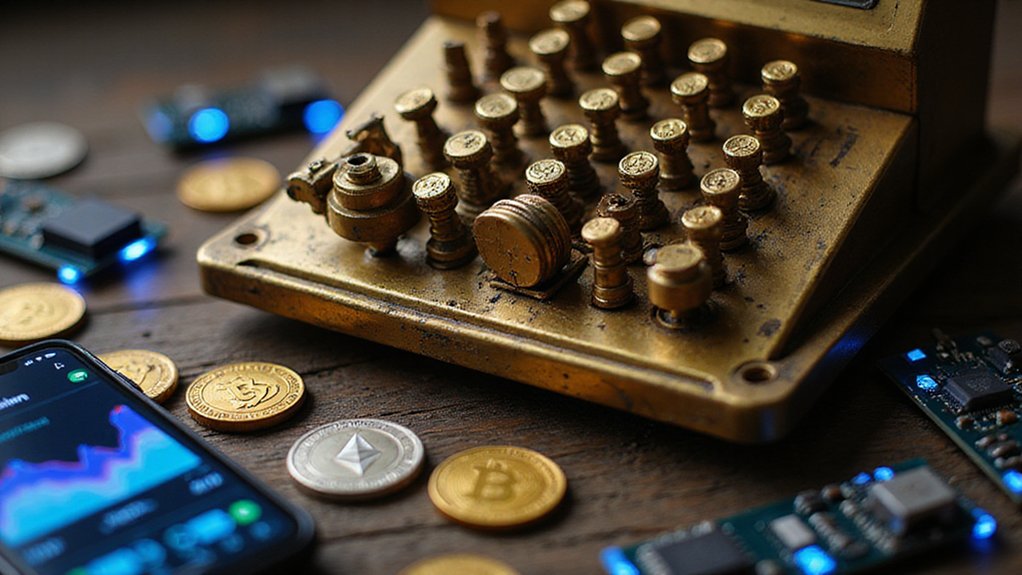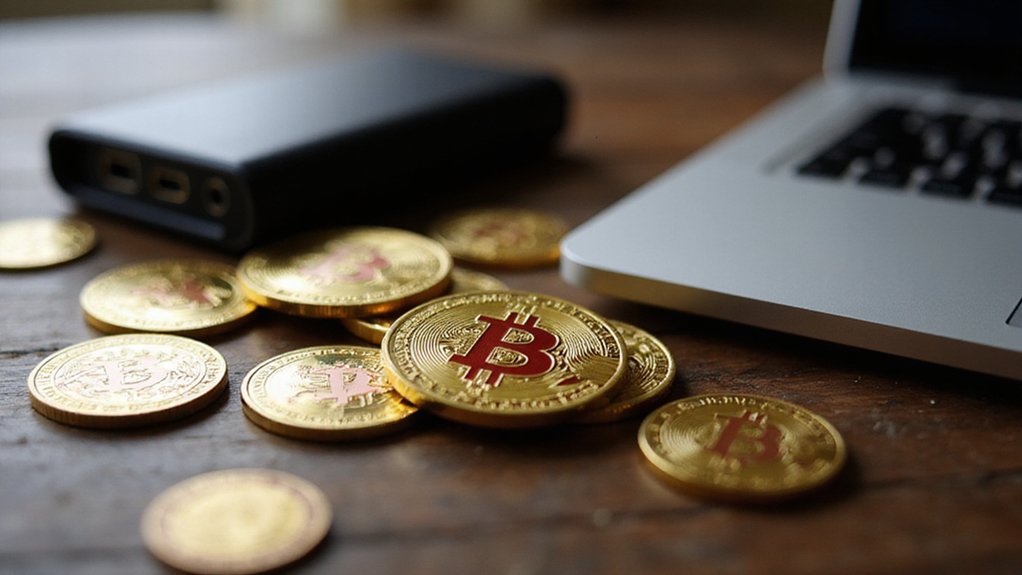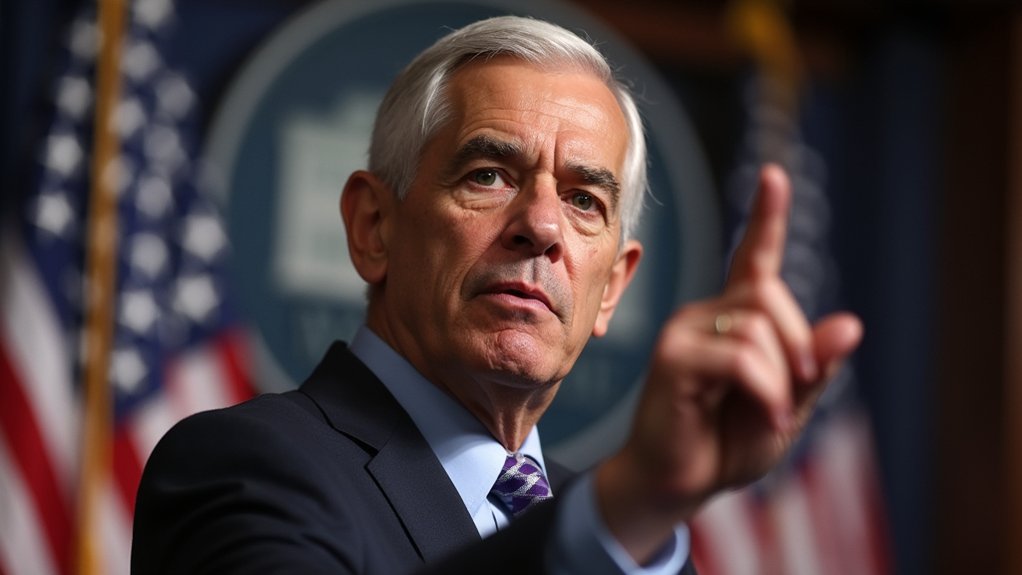Gas fee calculation operates through a straightforward formula: total cost equals gas units consumed multiplied by gas price per unit. Simple ETH transfers typically require 21,000 gas units, while complex smart contract interactions demand higher limits. The price comprises a network-adjusted base fee (measured in gwei) plus an optional priority tip for faster processing. Modern wallets automate these calculations, offering tiered speed options that create a computational auction where users fundamentally bid for network access—though mastering the timing and optimization strategies requires understanding the deeper mechanics.

Why do crypto transactions cost money when the entire premise of decentralized finance was supposedly to eliminate middlemen and their associated fees? The answer lies in computational economics: someone must pay for the processing power that validates transactions and maintains network security, and that someone is inevitably you.
Gas fees represent the cost of computational work performed by validators (formerly miners) when processing transactions on blockchain networks like Ethereum. The calculation follows a deceptively simple formula: multiply units of gas consumed by the gas price per unit. Since August 2021, Ethereum’s fee structure incorporates both a base fee—dynamically adjusted based on network congestion—and an optional priority fee (or “tip”) that incentivizes validators to process your transaction faster.
Gas fees create a computational auction where desperate users bid against each other for the privilege of network access.
The gas limit functions as your maximum spending authorization, typically set at 21,000 units for simple ETH transfers. Complex smart contract interactions demand noticeably higher limits, and here’s where things become particularly cruel: set your limit too low, and your transaction fails while still consuming all provided gas. It’s like paying full price for a meal you never receive.
Gas prices are denominated in gwei (10^-9 ETH), allowing for precise micro-payments. A practical calculation might involve 2 units of gas with an 11 gwei base fee plus 3 gwei priority tip: 2 × (11 + 3) = 28 gwei, or 0.000000028 ETH. This amount gets added to your transaction value, creating the total cost. Understanding that gwei equals one billion wei helps users grasp the granular nature of fee calculations and manage their transaction costs more effectively.
Network congestion drives base fees higher during peak usage, while transaction complexity determines actual gas consumption. The Ethereum Virtual Machine charges gas for every computational operation, meaning even token transfers (like DAI) require ETH for fees—a delicious irony that often catches newcomers off-guard. Beyond mere transaction processing, gas fees serve as a critical network security mechanism by providing validators with the financial incentive necessary to maintain blockchain integrity.
Modern wallets calculate these fees automatically, typically offering tiered options based on desired transaction speed. Users can select between economy, standard, and priority processing, with corresponding fee adjustments. The system effectively creates a marketplace where computational resources are auctioned to the highest bidders, ensuring network functionality while extracting maximum value from users desperate enough to pay premium rates for faster confirmation. To reduce costs, many users employ timing strategies like monitoring low-traffic periods using tools such as EtherScan to execute transactions when fees are minimal.
Frequently Asked Questions
What Happens if I Set My Gas Price Too Low?
Setting gas prices too low creates a predictable cascade of inconveniences.
Transactions languish in pending queues as miners prioritize higher-fee alternatives, potentially remaining unconfirmed indefinitely.
Network congestion exacerbates delays, while extremely low fees risk mempool ejection entirely.
Users face frustrating resubmission cycles, undermining time-sensitive DeFi operations.
The economic reality remains stark: miners optimize for profit, not altruism, leaving penny-pinching transactions in digital purgatory until fees increase sufficiently.
Can I Cancel a Transaction After Submitting It With Gas Fees?
Users can cancel cryptocurrency transactions only while they remain pending—before blockchain confirmation renders them permanently immutable.
The process involves replacing the original transaction using the same nonce with higher gas fees, fundamentally outbidding oneself for network priority.
Success isn’t guaranteed, particularly during network congestion when miners may process the original transaction first.
Once confirmed, cancellation becomes impossible, making this a race against the blockchain’s relentless march toward finality.
Do Failed Transactions Still Consume Gas Fees?
Yes, failed transactions consume gas fees—a particularly cruel irony of blockchain mechanics.
Validators must execute every submitted transaction to determine its validity, consuming computational resources regardless of outcome. Whether transactions fail due to “Out of Gas” errors, insufficient funds, or smart contract reverts, the network still charges fees for processing attempts.
Users cannot recover these costs since miners performed the actual work, making failed transactions an expensive lesson in blockchain economics.
Are Gas Fees the Same Across All Cryptocurrency Exchanges?
Gas fees vary dramatically across cryptocurrency exchanges, creating a rather bewildering landscape for traders.
Centralized platforms typically bundle gas costs into fixed withdrawal fees (often absorbing fluctuations themselves), while decentralized exchanges pass actual blockchain costs directly to users.
Network congestion, transaction complexity, and each platform’s fee structure contribute to this disparity.
Some exchanges even subsidize costs to attract volume, making direct comparisons practically impossible without careful analysis.
Why Do Gas Fees Fluctuate so Dramatically Throughout the Day?
Gas fees fluctuate dramatically throughout the day due to global network demand patterns that mirror traditional business cycles—ironic for a supposedly decentralized system.
Peak trading hours in major financial centers create congestion spikes, while off-peak periods see reduced activity and lower fees.
Users fundamentally engage in continuous auction warfare for limited block space, with prices swinging wildly as demand surges during market events, token launches, or whale movements across different time zones.









